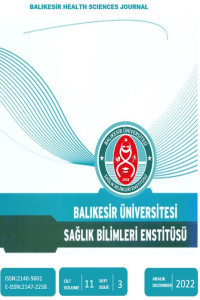Türkiye'deki Eczanelerde Bulunan Probiyotiklere Genel Bakış
Probiyotikler, Mikrobiyota, Nutrasötik, Eczacılık
Overview of Probiotics Available in Pharmacies in Turkey
Probiotics, Microbiota, Nutraceutical, Pharmacy,
___
- Barnett, J. A. (2000). A history of research on yeasts 2: Louis Pasteur and his contemporaries, 1850-1880. Yeast (Chichester, England), 16(8), 755–771. https://doi.org/10.1002/1097-0061(20000615)16:8<755::AID-YEA587>3.0.CO;2-4
- Bell, V., Ferrão, J., & Fernandes, T. (2017). Nutritional guidelines and fermented food frameworks. Foods, 6(8), 1–17. https://doi.org/10.3390/foods6080065
- Bermúdez-Humarán, L. G., Salinas, E., Ortiz, G. G., Ramirez-Jirano, L. J., Morales, J. A., & Bitzer-Quintero, O. K. (2019). From probiotics to psychobiotics: Live beneficial bacteria which act on the brain-gut axis. Nutrients, 11(4). https://doi.org/10.3390/nu11040890
- Champagne, C. P., Ross, R. P., Saarela, M., Hansen, K. F., & Charalampopoulos, D. (2011). Recommendations for the viability assessment of probiotics as concentrated cultures and in food matrices. International Journal of Food Microbiology, 149(3), 185–193. https://doi.org/10.1016/j.ijfoodmicro.2011.07.005
- Cordoba, A.& Hotel, A. C. P. (2001). Health and nutritional properties of probiotics in food including powder milk with live lactic acid bacteria. Prevention, 5(1), 1-10.
- Didari, T., Solki, S., Mozaffari, S., Nikfar, S., & Abdollahi, M. (2014). A systematic review of the safety of probiotics. Expert Opinion on Drug Safety, 13(2), 227–239. https://doi.org/10.1517/14740338.2014.872627
- Domig, K. J., Kiss, H., Petricevic, L., Viernstein, H., Unger, F., & Kneifel, W. (2014). Strategies for the evaluation and selection of potential vaginal probiotics from human sources: An exemplary study. Beneficial Microbes, 5(3), 263–272. https://doi.org/10.3920/BM2013.0069
- Doron, S., & Snydman, D. R. (2015). Risk and safety of probiotics. Clinical Infectious Diseases, 60(2), 129–134. https://doi.org/10.1093/cid/civ085
- Fuller, R. (1989). Probiotics in man and animals. J Appl Bacteriol, 66(5), 365-78. PMID: 2666378.
- Gasbarrini, G., Bonvicini, F., & Gramenzi, A. (2016). Probiotics History. Journal of Clinical Gastroenterology, 50(2), S116–S119. https://doi.org/10.1097/MCG.0000000000000697
- Grigoroff, S. (1905). Study on edible fermented milk: Kissélo-mléko‟ in Bulgaria [in French]. Revue Médicale de la Suisse Romande. Genéve: Libraires-Éditeurs. Librairie de L‟Université.
- Gu, R. X., Yang, Z. Q., Li, Z. H., Chen, S. L., & Luo, Z. L. (2008). Probiotic properties of lactic acid bacteria isolated from stool samples of longevous people in regions of Hotan, Xinjiang and Bama, Guangxi, China. Anaerobe, 14(6), 313–317. https://doi.org/10.1016/j.anaerobe.2008.06.001
- Hill, C., Guarner, F., Reid, G., Gibson, G. R., Merenstein, D. J., Pot, B., Morelli, L., Canani, R. B., Flint, H. J., Salminen, S., Calder, P. C., & Sanders, M. E. (2014). Expert consensus document: The international scientific association for probiotics and prebiotics consensus statement on the scope and appropriate use of the term probiotic. Nature Reviews Gastroenterology and Hepatology, 11(8), 506–514. https://doi.org/10.1038/nrgastro.2014.66
- Koziolek, M., Alcaro, S., Augustijns, P., Basit, A. W., Grimm, M., Hens, B., Hoad, C. L., Jedamzik, P., Madla, C. M., Maliepaard, M., Marciani, L., Maruca, A., Parrott, N., Pávek, P., Porter, C. J. H., Reppas, C., van Riet-Nales, D., Rubbens, J., Statelova, M., … Corsetti, M. (2019). The mechanisms of pharmacokinetic food-drug interactions – A perspective from the UNGAP group. European Journal of Pharmaceutical Sciences, 134, 31–59. https://doi.org/10.1016/j.ejps.2019.04.003
- McFarland, L. V. (2015). From yaks to yogurt: The history, development, and current use of probiotics. Clinical Infectious Diseases, 60(2), S85–S90. https://doi.org/10.1093/cid/civ054
- Metchnikoff, E. (1908). Lactic acid as inhibiting intestinal putrefaction.Mitchell, P. C. (Ed.), The prolongation of life; optimistic studies. (s.151-161). New York & London : G.P. Putnam's Sons.
- Motarjemi, Y. (2002). Impact of small scale fermentation technology on food safety in developing countries. International Journal of Food Microbiology, 75(3), 213–229. https://doi.org/10.1016/S0168-1605(01)00709-7
- Ozen, M., Dinleyici, E. C. (2015). The history of probiotics: The untold story. Beneficial Microbes, 6(2), 159–165. https://doi.org/10.3920/BM2014.0103
- Snydman, D. R. (2008). The safety of probiotics. Clinical Infectious Diseases, 46(2). https://doi.org/10.1086/523331
- Turkish Food Codex. Ministry of Agriculture and Rural Affairs. Official Gazette dated 7 July 2006 and numbered 26221, Ankara. Retrieved from: https://www.resmigazete.gov.tr/eskiler/2006/07/20060707-14.htm . (last accessed on: 27 January 2022).
- Trush, E. A., Poluektova, E. A., Beniashvilli, A. G., Shifrin, O. S., Poluektov, Y. M., & Ivashkin, V. T. (2020). The Evolution of Human Probiotics: Challenges and Prospects. Probiotics and antimicrobial proteins, 12(4), 1291–1299. https://doi.org/10.1007/s12602-019-09628-4
- ISSN: 2146-9601
- Yayın Aralığı: Yılda 3 Sayı
- Başlangıç: 2012
- Yayıncı: Balıkesir Üniversitesi
YouTube’da Diş Hekimliğinde Aerosol Yönetimi
Neslihan Büşra KESKİN, Emine KAYA
Gerilim Tipi Baş Ağrısında Akupunktur Tedavisinin Etkinliğinde Cinsiyetlerin Karşılaştırılması
Ruveyde AYDIN, Songül AKTAŞ, Dilek KALOĞLU BİNİCİ
Çocuklarda B12 Vitamini Eksikliği ve İlişkili Bulguların Sıklığı
Hilal AYDIN, Oğuzhan KORKUT, Ezgi ÖZDEN, Demet CAN
Tıbbi Beslenme Tedavisinde Güncel Bir Yaklaşım: Telenütrisyon
Keçi Sütüne Eklenen Farklı Süt Türlerinin Belirlenmesi İçin PCR Yöntemlerinin Karşılaştırılması
Rabia Mehtap TUNCAY, Yakup Can SANCAK
Muhammed Çağatay ENGİN, Serdar TOY, Kemal ZENCİRLİ, Mehmet Cenk TURGUT
Hülya ULUĞUT ERKOYUN, Erdem ERKOYUN
Gülşah AŞIK UYSAL, Mehmet CAN, Emrah ÖZCAN
Bir Üniversite Hastanesinde Çalışan Hemşirelerde Hemşireler Arası İş Birliği ve İş Stresi
